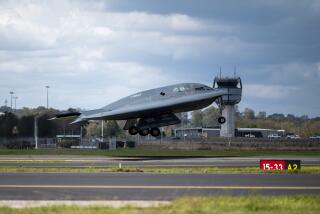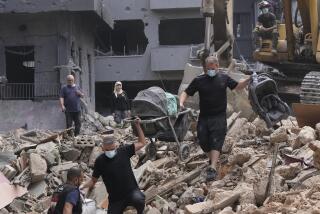Bombs Hit Civilian Areas of Afghan Cities, U.S. Says
- Share via
WASHINGTON — Three U.S. bombs went astray in weekend strikes in Afghanistan, landing in a residential neighborhood northwest of the capital, Kabul, and near a home for the elderly outside the city of Herat, Pentagon officials said Tuesday.
The two incidents were the latest examples of precision-guided weapons going awry in the U.S.-led military campaign--mistakes that could hurt Washington’s efforts to win support in some Islamic countries for its war on terrorism.
U.S. fighter jets and heavy bombers continued to strike forces loyal to the Afghan Taliban regime north of Kabul on Tuesday. Opposition fighters watched the strikes closely, hoping that the bombardment will open the way for their advance on the capital.
Pentagon officials also reported that a U.S. helicopter came under fire in Pakistan on Saturday. The aircraft was trying to retrieve the wreckage of a Black Hawk helicopter that crashed while providing support for a U.S. commando raid into Afghanistan staged earlier in the day.
The retrieval crew returned fire and left the area; no U.S. troops were hurt in the incident. It was the first time that a U.S. aircraft involved in the campaign has been shot at outside Afghanistan, Pentagon spokeswoman Victoria Clarke said. Many Pakistanis oppose their country’s role in the U.S. campaign.
Clarke said the Pentagon had no information on civilian casualties in the weekend bombing mistakes, in which a Navy F-14 dropped two 500-pound bombs on a residential area near Kabul on Saturday night and a Navy F/A-18 Hornet dropped a 1,000-pound bomb near a home for the elderly near Herat on Sunday morning.
Bombing Mistakes Called ‘Rare Errors’
There was some confusion about what had been hit in Herat. In Pakistan, a United Nations spokeswoman said U.S. air attacks had destroyed a military hospital on the eastern outskirts of Herat, according to reports from U.N. local staff in the area. The spokeswoman said the hospital was in a military compound.
Clarke said she was uncertain whether the U.N. report referred to the home for the elderly, which was 300 feet from a vehicle storage facility at an army barracks that had been the bomb’s intended target.
Taliban officials had claimed Monday that a hospital in the Herat area had been bombed, killing about 100 people. They asserted Tuesday that the civilian death toll since the U.S. air attacks began Oct. 7 has surpassed 1,000.
Clarke dismissed the Taliban claims as “outright lies” and said civilian casualties have been “extremely limited.”
“As we always say, we regret any loss of civilian life,” she said. “U.S. forces are intentionally striking only military and terrorist targets. We take great care in our targeting process to avoid civilian casualties.”
Still, analysts cautioned that even a small number of civilian deaths can damage the U.S. effort to maintain support among Arab and Muslim nations for the war on terrorism.
“It is a sensitive issue because of the question about whether this is a war against terrorism or whether this is a war on the Afghan people and a war on Islam,” said John Pike, an analyst with GlobalSecurity.org, a defense policy research firm in Alexandria, Va. “When you hit the right target, it’s a war on terrorism, and when you hit the wrong target, it’s a war on Islam.”
Rear Adm. John D. Stufflebeem, a senior official with the Joint Chiefs of Staff, called the errant bombings “rare errors.”
He also said he has seen evidence suggesting that some Taliban forces may be hiding in residential neighborhoods, aware of the efforts by the U.S. military to avoid hitting such areas.
The U.N. humanitarian coordinator’s office supported that theory Tuesday. The office said its representatives in Afghanistan reported that residential areas were indeed becoming more dangerous because Taliban troops have moved into them. The office said reports from Kabul indicated that several bombs have hit residential areas close to health and food aid centers.
So far, U.S. forces have used more than 3,000 bombs and missiles in the air attack on Afghanistan. On each mission, Stufflebeem said, “we’re going after a very specific military Taliban target, and we’re using very precise ways to get at it.”
Still, he acknowledged that technological or human errors can cause the weapons to miss their targets. Weather also can be a factor, he said; conditions such as dust, humidity or wind can affect the accuracy of the laser-guided bombs and missiles the U.S. has been using.
Stufflebeem said bombing continued Tuesday throughout Afghanistan.
About 80 U.S. fighter jets and bombers struck 11 target areas Monday, he said, including airfields, radar equipment, military garrisons, military training facilities, bunkers and moving targets such as tanks.
Many of the attacks, he asserted, focused on Taliban forces fighting opposition groups in northern Afghanistan.
As the airstrikes continue, Stufflebeem said that evidence is emerging that supply lines for Taliban troops and their allies in the Al Qaeda terrorist network have been disrupted, as have their housing and training facilities.
“We have struck all of the terrorist training camps that we are aware of,” Stufflebeem said.
He also charged that Taliban forces have taken over several Red Cross warehouses loaded with food and that they appear to be using the stored goods to feed troops rather than civilians.
“They’re denying that to the people who need it,” Stufflebeem said. “I make an assumption that they’re keeping that for themselves because they don’t have an ability to resupply easily.”
Monday’s operation utilized about 60 tactical jets based on three carriers in the region and about 10 land-based tactical aircraft, including AC-130 gunships, as well as about 10 long-range bombers.
Four C-17 cargo planes dropped 57,000 packages of food in Afghanistan on Tuesday, while the military helped U.S. aid officials deliver 30,000 blankets to Islamabad, the Pakistani capital, Stufflebeem said.
The Pentagon also disclosed that during Saturday’s commando raids into Afghanistan, the landing gear and part of the undercarriage of an MH-47 helicopter were sheared off when the aircraft hit a wall. The helicopter was flying fast and low as it ferried Army commando teams out of Afghanistan, officials said.
It returned safely to an undisclosed base, officials said.
*
Times staff writers Rone Tempest in Islamabad and John J. Goldman at the United Nations contributed to this report.
More to Read
Sign up for Essential California
The most important California stories and recommendations in your inbox every morning.
You may occasionally receive promotional content from the Los Angeles Times.










